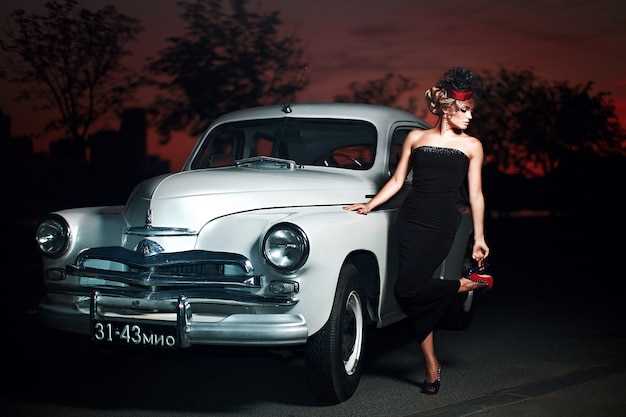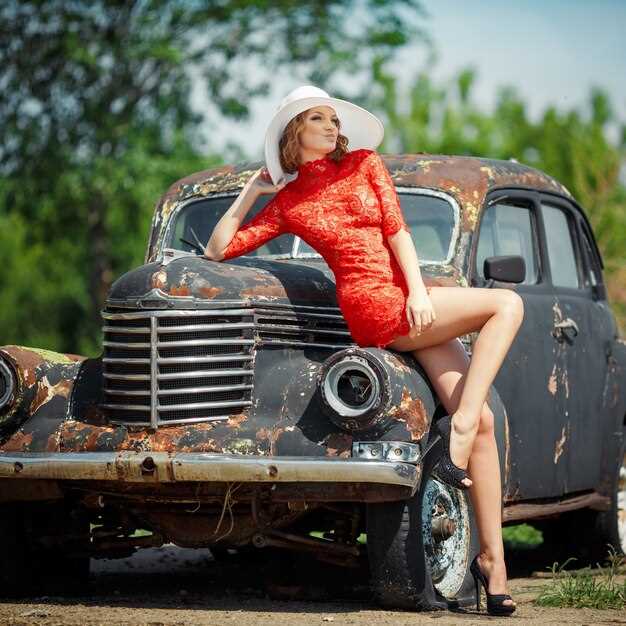
The world of muscle cars is often perceived as a male-dominated arena, characterized by roaring engines and high-speed races. However, beneath the surface of this dynamic culture, a significant number of women have played pivotal roles in shaping both the history and the identity of muscle cars. From pioneering drivers to influential designers, these women have not only contributed to the development of powerful vehicles but have also challenged gender norms within the automotive industry.
Throughout the decades, women have left an indelible mark on the muscle car scene, participating in events, competitions, and even engineering breakthroughs. Their contributions highlight a larger narrative about culture and inclusion, showcasing how diverse voices can enrich the automotive community. By examining the stories of these remarkable women, we gain a deeper understanding of the intersection between gender and automotive passion, and how they have collectively transformed a subculture into a more inclusive space.
As we delve into the lives of these trailblazers, we will uncover the challenges they faced and the legacies they built, illustrating how their efforts have reshaped perceptions and broadened the landscape of muscle car enthusiasm. Their stories serve as a reminder that the roar of an engine can be accompanied by the voices of women, forever altering the course of muscle car history.
Pioneering Female Racers and Their Contributions
Throughout automotive history, women have played a crucial role in shaping the culture of muscle car racing. Pioneering female racers broke barriers and challenged gender stereotypes, demonstrating exceptional skill on the track and influencing the development of the sport. These women not only raced cars but also paved the way for future generations, proving that passion for speed knows no gender.
One of the most notable figures is Shirley Muldowney, the first woman to earn a license from the National Hot Rod Association (NHRA) to compete in Top Fuel drag racing. With multiple championships to her name, Muldowney’s determination inspired a generation of aspiring female racers. Her contributions to the sport helped to establish a presence for women in a male-dominated environment, showcasing their capabilities in high-performance racing.
Another trailblazer is Linda Vaughn, who became known as the “Miss Hurst” and served as a promotional figure for the Hurst Performance Products. Vaughn’s efforts in marketing and promoting muscle cars during the 1960s and 1970s not only spotlighted the products but also added a unique flair and allure to the culture of muscle cars. She played a critical role in connecting fans with the excitement of racing and automotive innovation.
Kathy Egan made headlines as one of the first women to compete in professional road racing. Her success in various races challenged conventional notions of female participation in motorsports. Egan’s contributions to the sport included advocacy for greater inclusion of women in racing, which has gradually transformed perceptions within the automotive culture.
The influence of these pioneering female racers can still be seen today as the landscape of motorsports continues to evolve. Initiatives to promote inclusivity and provide support for women in racing are gaining momentum. The legacy of these women extends beyond their individual achievements, underscoring how women have shaped the muscle car culture and continue to inspire future racers. Their stories are not just about racing; they are about breaking boundaries and redefining what it means to be a part of automotive history.
Influential Women in Muscle Car Design and Engineering

Throughout automotive history, women have played a pivotal role in the design and engineering of muscle cars, often breaking barriers in a male-dominated industry. Their contributions have not only shaped the aesthetic and performance characteristics of these iconic vehicles but also paved the way for future generations of female engineers and designers.
One of the most notable figures is Mary Barra, who, as the CEO of General Motors, has influenced the direction of the entire automotive industry, including muscle car development. Her leadership emphasizes innovation and sustainability, while still paying homage to the classic muscle car heritage that many enthusiasts cherish.
In the 1960s, women like Frances McGowan at Ford Motor Company made significant strides in performance engineering. McGowan was instrumental in the development of the Mustang, ensuring its design met the expectations of spirited drivers while retaining strong performance metrics. Her insights into vehicle dynamics and aerodynamics contributed to the Mustang’s status as an enduring symbol of American muscle.
Another influential woman is Linda Vaughn, known as the “First Lady of Motorsports.” Although not an engineer in the traditional sense, she played a crucial role in promoting muscle cars during their golden era. As a skilled driver and spokesperson, Vaughn helped elevate the profile of muscle cars, making them not just vehicles but cultural icons associated with speed, power, and freedom.
In modern times, women like Ann Marie Sgarlata, a talented engineer at FCA, have continued to push the boundaries of muscle car performance and design. Her work on the Dodge Charger and Challenger reflects a deep understanding of what muscle car enthusiasts seek: raw power combined with cutting-edge technology. Sgarlata’s commitment to excellence ensures that these vehicles remain competitive in today’s automotive market.
These women, along with many others, exemplify the essential contributions of female drivers and engineers in the muscle car sector. Their legacies inspire the next generation of women to pursue careers in automotive design and engineering, proving that passion and talent know no gender.
The Role of Women in Car Customization and Modification
Women have significantly contributed to car customization and modification, challenging traditional stereotypes in the automotive industry. Throughout history, female drivers have emerged as skilled mechanics, designers, and innovators, breaking barriers and redefining the landscape of automotive culture.
Women in the Garage
Many women have taken on roles in the garage, showcasing their expertise in vehicle modification. They have become adept at transforming stock cars into personalized expressions of creativity and performance. This hands-on involvement not only highlights their technical skills but also serves to inspire a new generation of female drivers to explore the world of automotive customization.
Influential Female Customizers
Various women have made their mark in the customization scene, from well-known figures to grassroots enthusiasts. Pioneers like Linda Vaughn, known as the “First Lady of Motorsports”, and contemporary customizers such as Jessie Combs have showcased their talents, pushing the boundaries of design and engineering. These women have not only modified vehicles but have also elevated the status of women in the industry.
Community and Culture
Women have been instrumental in fostering communities focused on car modification. Organizations and events aimed at female drivers foster an inclusive environment where women can share knowledge, skills, and experiences. These communities encourage participation from all skill levels, empowering women to take on customization projects that reflect their personal style and preferences.
Breaking Stereotypes
The involvement of women in car customization and modification challenges societal norms. By excelling in a field traditionally dominated by men, female drivers demonstrate that passion and skill are not limited by gender. Their contributions emphasize the importance of diversity within the automotive culture, highlighting the value of different perspectives in the creative process.
Ultimately, the role of women in car customization and modification is integral to the evolution of automotive culture. Their passion, creativity, and technical expertise continue to shape the industry while promoting a more inclusive environment for future drivers.
Female Ownership: Shifting Dynamics in Muscle Car Culture
Traditionally dominated by men, muscle car culture has seen a significant shift in dynamics with the rise of female ownership. More women are embracing muscle cars, not just as passengers or enthusiasts but as owners and influencers within this vibrant culture. This change is partly driven by the increasing visibility of women in the automotive industry and motorsports, which has inspired many to break gender norms.
Women have begun to make their mark in various aspects of the muscle car scene, from restoration and modification to racing and car shows. This active participation is reshaping perceptions and challenging stereotypes associated with muscle car ownership. Social media platforms have played a crucial role in amplifying female voices, allowing them to share their experiences and connect with like-minded individuals. As a result, women have created a supportive community that encourages both seasoned enthusiasts and newcomers to engage with muscle cars.
The growing presence of women in this culture is also impacting automotive marketing and design. Manufacturers are starting to recognize the importance of catering to female consumers, leading to the development of new models and features that appeal to a broader audience. This shift not only benefits women but also enriches the muscle car market as a whole, fostering diversity and innovation within the culture.
In conclusion, female ownership in the muscle car world represents a crucial evolution in its culture. As women continue to assert their presence, they challenge preconceived notions and create an inclusive environment that celebrates passion for these iconic vehicles. The landscape of muscle car culture is changing, and women are at the forefront of this exciting transformation.
Prominent Female Figures in Muscle Car Events and Rallies
Women have played a significant role in shaping the culture of muscle cars through their active participation in events and rallies. Their contributions not only challenge stereotypes but also inspire future generations of female automotive enthusiasts.
Key female figures in muscle car events include:
- Linda Vaughn: Known as the “First Lady of Motorsports,” Vaughn gained fame as a promotional model in the 1960s and 1970s. Her charismatic presence helped popularize muscle car culture and made her an iconic figure at various racing events.
- Erin McGhee: A prominent figure in the muscle car community, McGhee has organized numerous events aimed at empowering women in motorsports. Her initiatives focus on increasing female participation in car shows and rallies.
- Vicki Cummings: An accomplished racer, Cummings has broken barriers in a male-dominated sport. She has participated in many muscle car rallies, showcasing her skills and encouraging young women to pursue their passion for automotive racing.
- Michelle Christensen: As a well-known automotive designer, Christensen has influenced muscle car aesthetics and performance. Her work promotes the importance of female involvement in automotive design and motorsport.
These women not only compete but also contribute to a vibrant community where women feel empowered to embrace their passion for muscle cars. By participating in events and rallies, they shape the culture surrounding muscle cars, proving that automotive enthusiasm transcends gender.
In conclusion, the impact of women in muscle car events is profound. Their involvement continues to inspire and enrich the culture, making it more inclusive and diverse.
Challenges Faced by Women in the Muscle Car Community

Women in the muscle car community have historically faced numerous challenges that have shaped their experiences as drivers and enthusiasts. One prominent difficulty has been the prevailing stereotypes that often dismiss women as less capable or knowledgeable about cars. This perception can lead to a lack of respect from male counterparts, making it challenging for women to assert themselves in a traditionally male-dominated culture.
Additionally, women frequently encounter barriers when trying to access resources such as tools, workshops, and racing events. Many of these environments have been tailored to male participants, creating a sense of exclusion for female drivers. This can hinder their ability to participate fully in the community, whether through racing, car restoration, or social engagement.
Networking opportunities also pose challenges for women within the muscle car culture. Many events may not actively promote inclusivity, leading to women feeling isolated. The lack of female role models can discourage new entrants from pursuing their passion for muscle cars, as the visibility of successful women in the industry remains limited.
In recent years, the muscle car community has begun to evolve, with more women taking on leadership roles and influencing the culture. Despite this progress, persistent gender biases and logistical challenges remind us that the path for female drivers in this sphere continues to be fraught with obstacles. Addressing these issues is essential for fostering a more inclusive environment for all car enthusiasts.




